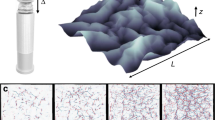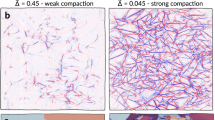Abstract
A crumpled piece of paper is made up of cylindrically curved or nearly planar regions folded along line-like ridges, which themselves pivot about point-like peaks; most of the deformation and energy is focused into these localized objects. Localization of deformation in thin sheets is a diverse phenomenon1,2,3,4,5,6, and is a consequence of the fact7 that bending a thin sheet is energetically more favourable than stretching it. Previous studies8,9,10,11 considered the weakly nonlinear response of peaks and ridges to deformation. Here we report a quantitative description of the shape, response and stability of conical dislocations, the simplest type of topological crumpling deformation. The dislocation consists of a stretched core, in which some of the energy resides, and a peripheral region dominated by bending. We derive scaling laws for the size of the core, characterize the geometry of the dislocation away from the core, and analyse the interaction between two conical dislocations in a simple geometry. Our results show that the initial stages of crumpling (characterized by the large deformation of a few folds) are dominated by bending only. By considering the response of a transversely forced conical dislocation, we show that it is dynamically unstable above a critical load threshold. A similar instability is found for the case of two interacting dislocations, suggesting that a cascade of related instabilities is responsible for the focusing of energy to progressively smaller scales during crumpling.




Similar content being viewed by others
References
Calladine,C. Theory of Shell Structures (Cambridge Univ. Press, Cambridge, 1983).
Wierzbicki,T. & Jones,N. (eds) Structural Failure (Wiley Interscience, New York, 1988).
Connelly,R. Rigidity and energy. Invent. Math. 66, 11–33 (1982).
Nelson,D. R., Piran,T. & Weinberg,S. Statistical Mechanics of Membranes and Surfaces (World Scientific, Singapore, 1988).
Amirbayat,J. & Hearle,J. W. S. The complex buckling of flexible sheet materials. Int. J. Mech. Sci. 28, 339–370 (1986).
da Vinci, Leonardo Notebooks Vol. I., Studies of Drapery (Dover Reprint, New York, 1984).
Rayleigh, Lord, Theory of Sound Vol. I, Ch. X a (Dover, New York, 1945).
Lobkovsky,A., Gentges,S., Li,H., Morse,D. & Witten,T. Stretched ridges in crumpling. Science 270, 1482–1485 (1995).
Lobkovsky,A. & Witten,T. A. Properties of ridges in elastic membranes. Phys. Rev. E 55, 1577–1589 (1997).
Chaieb,S. & Melo,F. Experimental study of developable cones. Phys. Rev. Lett. 80, 2354–2357 (1998).
Cerda,E. & Mahadevan,L. Conical surfaces and crescent singularities in crumpled sheets. Phys. Rev. Lett. 80, 2358–2361 (1998).
Ben Amar,M. & Pomeau,Y. Crumpled paper. Proc. R. Soc. Lond. A 453, 729–755 (1997).
Nabarro,F. R. N. Theory of Crystal Dislocations (Dover, New York, 1993).
Struik,D. J. Lectures on Classical Differential Geometry (Dover, New York, 1988).
Love,A. E. H. A Treatise on the Mathematical Theory of Elasticity (Dover, New York, 1944).
Timoshenko,S. & Gere,J. Theory of Elastic Stability (McGraw-Hill, New York, 1961).
Kramer,E. & Lobkovsky,A. Universal power law in the noise from a crumpled elastic sheet. Phys. Rev. E 53, 1465–1468 (1996).
Houle,P. & Sethna,J. Acoustic emission from crumpling paper. Phys. Rev. E 54, 278–283 (1996).
Acknowledgements
E.C. was supported by the Chilean Presidente de la República postdoctoral fellowship during the course of this work at MIT in 1997–98. S.C. was supported by a postdoctoral fellowship at Universidad de Santiago de Chile in 1997–98 during the course of this work. Additional support was provided by the Chilean Cátedra Presidencial en Ciencias (F.M.), the Karl van Tassel career development chair and the Sloan fund (L.M.) at MIT.
Author information
Authors and Affiliations
Corresponding author
Rights and permissions
About this article
Cite this article
Cerda, E., Chaieb, S., Melo, F. et al. Conical dislocations in crumpling. Nature 401, 46–49 (1999). https://doi.org/10.1038/43395
Received:
Accepted:
Issue Date:
DOI: https://doi.org/10.1038/43395
- Springer Nature Limited
This article is cited by
-
Enhanced Flexoelectric Response from Functionally Gradient Electrets Undergoing Crumpling Deformation
Acta Mechanica Solida Sinica (2024)
-
Mechanics of moving defects in growing sheets: 3-d, small deformation theory
Materials Theory (2020)
-
Buffering by buckling as a route for elastic deformation
Nature Reviews Physics (2019)
-
The compressive strength of crumpled matter
Nature Communications (2019)
-
A state variable for crumpled thin sheets
Communications Physics (2018)





